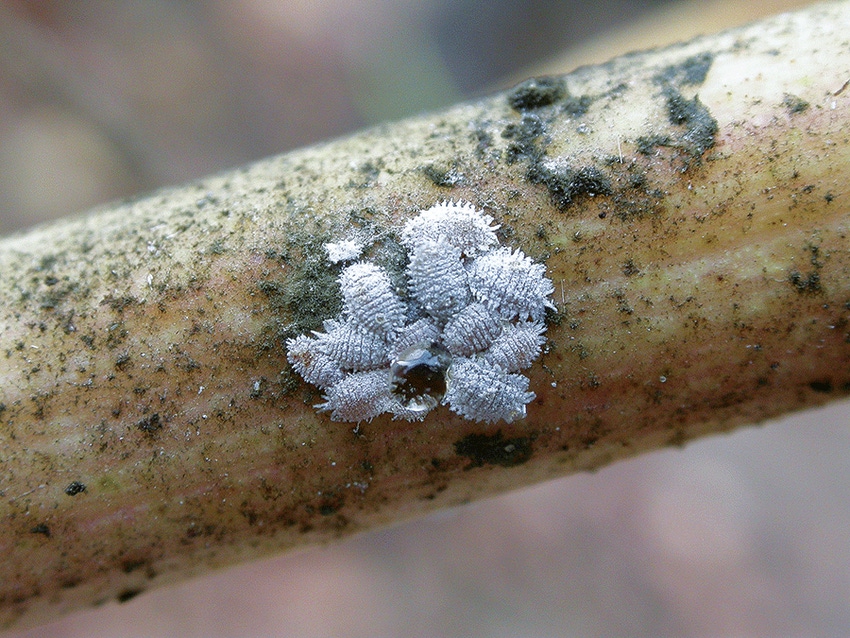
Mating disruption to control vine mealybug in table grapes is showing promise in University of California studies.
The pest, Planococcus ficus, is the most significant one in California table grapes, says UC Cooperative Extension Entomologist David Haviland. The University of California IPM website describes it as small, soft, oval, flat, distinctly segmented, and covered with a white, mealy wax that extends into spines.
Extension Viticulture Advisor Dr. Asraf El-kereamy says the pest not only renders table grapes unmarketable because the honeydew left behind that can resemble candle wax, but the pest is known also to vector grapevine leafroll virus.
Ants can compound management issues as they feed on the honeydew left behind by the mealybugs. For this reason, ants can become protective of mealybugs, which can have a negative impact on parasitoid populations that could otherwise help integrated pest management control of the mealybug.
Vine mealybugs can also render winegrapes unmarketable, but is perhaps more troublesome because leafroll virus in those vines can make it difficult, if not impossible, for the grapes to achieve minimum sugar levels, according to Fresno County Viticulture Advisor George Zhuang.
SPRAYABLE PHEROMONE FORMULATIONS
Research trials of new mating disruption techniques conducted by Haviland indicate that sprayable formulations of pheromone have improved performance over a previous dispenser-based system that was costlier.
In theory, mating disruption works by inundating vineyards with artificial vine mealybug pheromone, Haviland notes in a paper shared at a recent viticulture symposium in central California. This inhibits the ability of males to find females and reduce reproduction.
In 2016 and 2017, he studied CheckMate VMB-F, a Suterra product labeled for grapes in California. The study used three different vineyards in Kern County. Four treatments in each vineyard included mating disruption treatments applied with common vineyard spray equipment at 30-day and 45-day intervals. Plots were also aggressively treated with labeled insecticides to combat vine mealybug and other pests.
CheckMate VMB-F is a new formulation of the pheromone that is micro-encapsulated into millions of tiny bubbles within a liquid. The product was poured into a standard vineyard spray tank with water and applied to the vines. Application rates were 5 grams of active ingredient per acre.
SIGNIFICANT IMPACT
Mating disruption in the 30-day plots had a significant impact on adult males captured in traps at all three sites, Haviland says. At the applied rate, pheromone traps were negatively impacted during the period, which is the approximate length of one generation of vine mealybug during the summer months.
Applications of pheromone at 45-day intervals did not effectively disrupt mating. The caveat, he says, is that control during the first 30 days was good, but then quickly fell off until the next treatment was made.
Plots sprayed at 30-day intervals received five applications in 2017, beginning June 1. All plots, regardless of whether they received pheromone applications, were sprayed with a series of four or five commercially-approved insecticides, Haviland says. The insecticides remained constant within each vineyard application. Plots were evaluated for vine mealybug males collected in six pheromone traps per plot. Damage at harvest was determined by evaluating 1,200 clusters per plot for the pest.
CONCLUSIONS
Data suggest that adding mating disruption to traditional spray programs for vine mealybug in table grapes can enhance control, he says. While his trials had low populations of vine mealybug because of the aggressive insecticide treatments, it can be assumed that mating disruption in vineyards with less-aggressive treatment regimens can benefit by the pheromone treatments.
More studies are warranted, Haviland says, to determine if vineyards with increased vine mealybug pressure can be effectively treated with fewer insecticides, while still using mating disruption techniques.
About the Author(s)
You May Also Like






